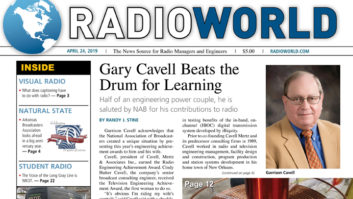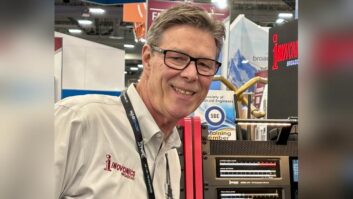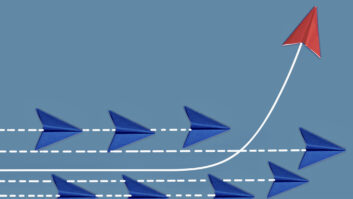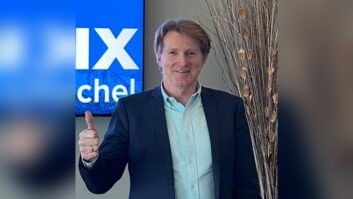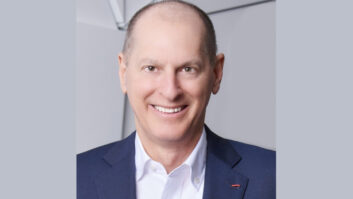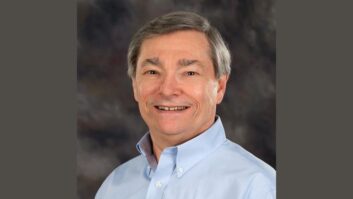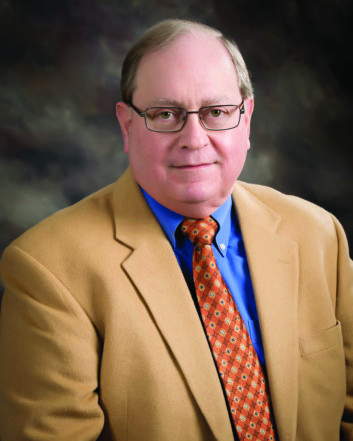
©2015 Patty Schuchman Photography LLC
Garrison Cavell acknowledges that the National Association of Broadcasters created a unique situation by presenting this year’s engineering achievement awards to him and his wife.
Cavell, president of Cavell, Mertz & Associates Inc., earned the Radio Engineering Achievement Award. Cindy Hutter Cavell, the company’s senior broadcast consulting engineer, received the Television Engineering Achievement Award, the first woman to do so.
“It’s obvious I’m riding my wife’s coattails,” said Cavell said with a chuckle.
He really doesn’t have to. Cavell’s career in broadcast engineering has spanned more than 40 years, during which time he has designed, built and certified “countless” station antenna systems; he also been deeply involved in testing benefits of the in-band, on-channel (IBOC) digital transmission system developed by iBiquity.
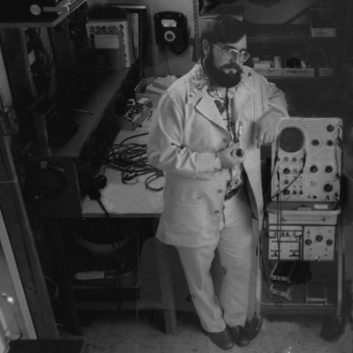
[All-Digital AM Starts Here]
Prior to co-founding Cavell Mertz and its predecessor consulting firms in 1989, Cavell worked in radio and television engineering management, facility design and construction, program production and station systems development in his home town of New Orleans.
Cavell, 68, is a licensed pilot and former professional drummer. He has been around long enough to credit part of his success to mentors like Jules Cohen and Robert and Tom Silliman (all of whom are past NAB honorees) but humble enough to admit he still learns something new about his profession every day.
Lynn Claudy, senior vice president of technology at NAB, said, “In addition to all the excellent engineering consulting he’s done for station clients over the years, Gary has generously volunteered his time to NAB as a faculty member at NABEF’s Broadcast Leadership Training Program for almost two decades, and more recently the Technology Apprentice Program.”
He also served as editor in chief for the 11th Edition of the NAB Engineering Handbook published in 2017, a huge tome that was completed on time, Claudy said, principally because of Cavell’s commitment to the project as a labor of love.
THE FCC “WILL PROVIDE”
Cavell, an IEEE and SMPTE Life Member, grew up in the Big Easy with an interest in radio, antennas and ham radio. He began his career at in Houma, La., at KCIL(FM) and KJIN(AM) as an announcer and engineering assistant.
“I was a kid playing country music and even some Cajun music. But it just so happened that the owner of the radio stations got involved with TV and invited me to help him build a television station in Houma. That was really the start of my technical career,” he said.
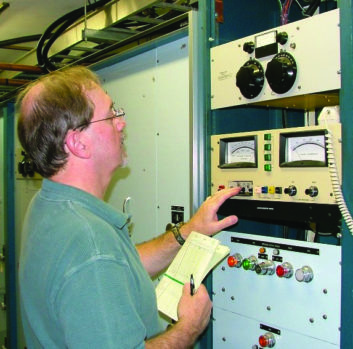
There are topics Cavell declined to discuss in depth for this interview, including AM revitalization because of ongoing work for the NAB and FCC. In regard to the commission taking steps to overhaul ownership rules, he said there seems to be a mixed bag of arguments for and against.
“Of course, you have clients on both sides of many issues, whether it is changing the AM rules and updating the protections for the Class As or the move to launch C4 FM service. We really can’t take a position because someone will be cheesed off,” Cavell said.
But Cavell said the commission’s efforts to lighten its regulatory touch on broadcast has resulted on plenty of work for firms like his.
[Cavell: AM Revitalization Is Still a Work in Progress]
“The FCC’s moves to modernize media regulations and modify rules that are outdated and burdensome for broadcasters generally means more work for people who are in the business of offering help,” he said. “Jules Cohen once told me, ‘Don’t worry, the FCC will always provide.’”
Cavell remains passionate about drawing more youth into broadcast engineering careers. He is supportive of the NAB Educational Foundation, the Society of Broadcast Engineers and their training programming for technical apprentices and interns.
“Mentoring is so crucial to help open doors. But there are two parts to the issue. First, traditional radio and television isn’t as exciting as it was once. It’s not top of mind, and there is lots of competition from other technical fields.
“Secondly, I know the compensation level for entry level folks is not as high as it should be,” Cavell said. “So we have to get the attention of new young blood and then pay them fairly.”
The radio and TV industry needs to bring in young talent specifically to focus on computer networking, he said, where the “major growth will be the next decade.”
IT’S ALL ABOUT THE …
Cavell reflected further on vast changes in the radio business throughout his career, from new technology to industry consolidation.
“It’s really interesting. Computers have impacted us the most. We don’t have to lay maps out all over the floor and draw lines on them. That was how we did it. Now you push a button and you get the same data. It’s so efficient. I can do a Moment of Method Proof for an AM station in a fraction of the time. It’s amazing. I think we charge about the same today for a project today as we did in 1989 because the time involved is so much less.”
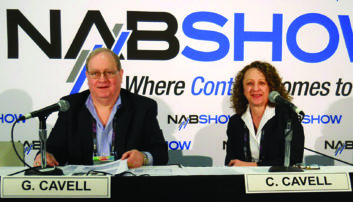 He continued, “On the business side, radio consolidation has really impacted how we do business. It used to be we did business with dozens and dozens of broadcast groups. Now there are just a few, and that really has changed the dynamic of our business.”
He continued, “On the business side, radio consolidation has really impacted how we do business. It used to be we did business with dozens and dozens of broadcast groups. Now there are just a few, and that really has changed the dynamic of our business.”
Cavell said he believes over-the-air radio will remain relevant as long as broadcasters focus on content.
“Here is an engineer telling you it’s all about content, but it really is. If you put something on the air that people want to hear, they will tune in. It’s about content and always has been about content. Even as new technology develops, content will be crucial in order to get people to consume the product.”
However, he expressed surprise that some broadcasters have been slow to adopt HD Radio, considering its benefits, including extra channels.
“I thought as an industry it would be quicker… . Some broadcasters have been very forward thinking in launching HD Radio and finding ways for it to make sense for them. Others have shied away and more concerned about the cost factor.”
[The FCC at 75: Still Relevant?]
Cavell Mertz regularly conducts experiments in HD Radio on AM and FM for NAB’s Pilot program. Its test bed supports analog, hybrid and all-digital testing of both AM and FM-band radio signals, he said.
“We test in various modes. We look at interference issues, performance issues and RDS issues. Folks from Xperi and Nautel are in here quite often,” he said.
The firm is involved in testing all-digital HD Radio on the medium-wave band at Hubbard’s WWFD(AM) in Frederick, Md., as Radio World has reported. Xperi and Kintronic Laboratories are also involved in the project, which is operating under special experimental authority.
“I’m very excited about the all-digital AM project for Hubbard. I’m completely jazzed about it. It offers in my mind a viable way for AM to go,” he said. “It’s quieter and has FM fidelity. Hubbard is very happy with how things are going.”
The firm also conducted co-channel interference field studies on all-digital AM for NAB.
SORROWS AND JOYS
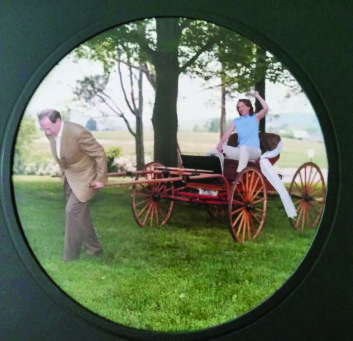
Cavell Mertz suffered a setback when it lost one of its principals, Richard Mertz, to pancreatic cancer in 2013. Mertz joined the company in 1994 and was critical to its growth, according to Cavell.
“It took the heart out of us for a while. In many aspects, Richard was fearless. His background was in physics so he gave us a lot of depth in that area when faced with difficult calculations. He was the perfect foil. That is what made the firm so great is that we had different personalities,” Cavell said.
Cavell Mertz has nine full-time employees and regularly calls upon a half-dozen contractors to help with the firm’s TV repack consulting work for the FCC, he said. It frequently works with the accounting firm Ernst & Young, a TV repack fund administrator hired by the FCC.
“We work as their subject matter expert. It’s another of those topics I can’t discuss thoroughly. We are not doing any TV repack work for broadcasters.”
Cavell has no plans for retirement, even though he hopes to someday fly his Cessna 18 Skylane more often. “This is still fun. I love helping people and teaching folks. I’ve been doing this for so long but I’m still happy. So I have no plans to pass the firm along or shut it down,” he said. “I give my thanks to NAB for this recognition. I’m not very interesting, but the things I work on sure are.”
[From AoIP to Elsie the Cow: Broadcasting Books of Note]
How did he and Cindy become an engineering power couple? Cavell related the story to RW sister publication TV Technology: “I met her at NBC here in Washington while I was working on a TV project, and we just became buddies because I liked how she handled people. I thought it was kind of funny because she worked with these big, burly guys, and she just handled it.”
She eventually became a client of the firm. “You get to know somebody in a different light than the usual dating or courtship relationship. We were professional and then personal friends for years. But eventually she persuaded me to marry her, and I persuaded her to come to this company.”
They wed in 2005, and she joined the firm in 2010.
“Cindy is outbilling me now. That’s no secret,” he told RW. “We work great together. She has her portion of the practice, and I have mine. She works mostly on TV. We do have an agreement never to discuss business at home unless it’s very urgent.”
The couple resides in Haymarket, Va., just west of Washington, D.C., near the Bull Run Mountains.
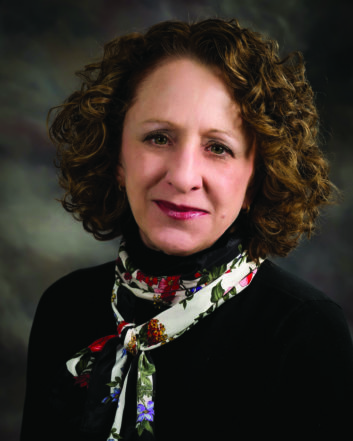
©2015 Patty Schuchman Photography, LLC
CINDY HUTTER CAVELL
The recipient of the 2019 NAB Television Engineering Achievement Award, Cindy Hutter Cavell serves as senior broadcast consulting engineer at Cavell, Mertz & Associates Inc. with a specialty in television station and microwave system design and implementation. According to NAB, her career includes stints as director of operations at ABC News’ Washington Bureau, engineering director for several local TV stations, vice president of Fox Sports’ Houston Technical Operations Center and broadcast engineering director for Sprint Communications.
As part of the ABC Broadcast Operations and Engineering team, Cavell won three Emmy Awards for Technical Innovation. She is the recipient of the AWRT/SBE 2007 Outstanding Female Broadcast Engineer award and holds the 2015 TVNewsCheck Women in Technology Award.
She is the first woman to receive the NAB Engineering Achievement Award. “I am proud to be part of a community that used to be called a brotherhood,” she told TV Technology. “We’ve come a long way from the early 1970s when I got into the business when women were few and far between.” Read TVT’s interview with the couple at http://tinyurl.com/rw-huttercavell.
HONOR ROLL
Recipients of the NAB Engineering Achievement Award are listed here. Beginning in 1991, radio and TV winners were named; only radio winners are shown below for those years.
- 1959 John T. Wilner
- 1960 T.A.M. Craven
- 1961 Raymond F. Guy
- 1962 Ralph N. Harmon
- 1963 Dr. George R. Town
- 1964 John H. DeWitt Jr.
- 1965 Edward W. Allen Jr.
- 1966 Carl J. Meyers
- 1967 Robert M. Morris
- 1968 Howard A. Chinn
- 1969 Jarrett L. Hathaway
- 1970 Philip Whitney
- 1971 Benjamin Wolfe
- 1972 John M. Sherman
- 1973 A. James Ebel
- 1974 Joseph B. Epperson
- 1975 John D. Silva
- 1976 Dr. Frank G. Kear
- 1977 Daniel H. Smith
- 1978 John A. Moseley
- 1979 Robert W. Flanders
- 1980 James D. Parker
- 1981 Wallace E. Johnson
- 1982 Julius Barnathan
- 1983 Joseph Flaherty
- 1984 Otis S. Freeman
- 1985 Carl E. Smith
- 1986 Dr. George Brown
- 1987 Renville H. McMann
- 1988 Jules Cohen
- 1989 William Connolly
- 1990 Hilmer Swanson
- 1991 George Marti
- 1992 Edward Edison & Robert L. Hammett
- 1993 Robert M. Silliman
- 1994 Charles T. Morgan
- 1995 Robert Orban
- 1996 Ogden Prestholdt
- 1997 George Jacobs
- 1998 John Battison
- 1999 Geoffrey Mendenhall
- 2000 Michael Dorrough
- 2001 Arno Meyer
- 2002 Paul Schafer
- 2003 John W. Reiser
- 2004 E. Glynn Walden
- 2005 Milford Smith
- 2006 Benjamin Dawson & Ronald Rackley
- 2007 Louis A. King
- 2008 Thomas B. Silliman
- 2009 Jack Sellmeyer
- 2010 Steve Church
- 2011 L. Robert du Treil
- 2012 Paul Brenner
- 2013 Frank Foti
- 2014 Jeff Littlejohn
- 2015 Thomas F. King
- 2016 Andy Laird
- 2017 John Kean
- 2018 Tom Jones
- 2019 Garrison Cavell
